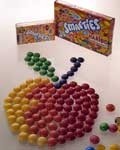Special edition: natural colours
Ongoing research in natural colours
Natural colours lost their appeal when synthetic colours arrived on the scene, as they provide less consistency, heat stability and colour range than their chemical alternatives. Moreover, natural colours are more expensive.
However, as consumer awareness increases over the link between diet and health and trends move towards more clean-label products, natural colourings are back in fashion.
Reds
According to Leatherhead Food International (LFI), natural red pigments are anthocyanins, betalains, and carotenoids sourced from berries and grapes, red beetroot, and red fruit, vegetables and flowers, respectively.
The most widely used natural pigments in the red-purple colour range are anthocyanins. However, these compounds are relatively unstable above pH 3. This means that betacyanins, and betalains in particular, are the natural pigments of choice to provide red-purple colour to low acid foods.
Moreover, vitamin C (ascorbic acid) can stabilise betalains making the pigments applicable in food with high ascorbic acid contents. On the other hand, vitamin C can impair anthocyanin stability.
While price pressure currently favour betalains from red beet, several disadvantages, including unfavourable flavour components, no nitrate accumulation, and the risk of microbe carry-over from the earth, are pushing scientists to examine alternative sources for the compounds.
Hohenheim University researchers examined the potential of betalain-rich extracts from pitaya and cactus pear to offer reds for food. According to their research, published in Innovative Food Science and Emerging Technologies (Dec 2006, Vol. 7, pp. 275-287), the main limitation for commercialisation of the cactus pear pigments at this moment appears to be the current market prices of the fruit, but may be economical as a functional ingredient since the concentrate is also rich in amino acids, calcium, magnesium, and moderate levels of vitamins.
Yellows
The key natural compounds responsible for yellow colours available to food scientists include annatto, beta-carotene, lutein, mixed carotenoids, riboflavin, and curcumin, said LFI.
Companies such as Wild and Chr Hansen offer a range of yellow and orange pigments based on carotenoids, for example.
Yellow pigments may also be sourced from cactus pear, according to the Hohenheim University researchers.
In addition, researchers from France's Institute for Agronomy Research (INRA) have been studying the potential of the natural yellow pigment, POP (phloridzine oxidation product), which is a by-product of cider production.
In collaboration with cider company Val de Vire, research led to a patent in the structure, and how it is obtained, of POP. The compound has antioxidant properties and is obtained from apples. It can be used in both the food and cosmetic industries.
The POP pigment, which has been purified, produces a brilliant yellow colour with two nuances depending on the acidity of the medium. It is yellow for products with an acidity of less than pH 5 and orange for products with a pH 6, reported the INRA scientists in 2006.
Blues
Scientists have also been searching for a true blue colouring in food. Nestle Rowntree recently re-launched its blue Smarties, after finding a suitable natural alternative to the colouring Brilliant Blue (E133). After an extended period of development, the blue Smartie is now back thanks to Spirulina, which is produced from two species of cyanobacteria (blue-green lake algae).
Danish colours firm Chr Hansen also offers a natural blue sourced from anthocyanins and for use in the pH range from 5.5 to 8.
Very recently, FoodNavigator.com reported on a potential new source of blue pigments for the food industry. French researchers reported that a blue-green pigment from microalgae responsible for the greening of oyster gills may also provide a natural blue-green colouring for food.
The compound called marennine, produced by the microalgae Haslea ostrearia, not only has potential to act as a pigment, but it also “exhibit[s] significantly higher antioxidative and free radical scavenging activities than natural and synthetic antioxidants commonly used in food,” wrote researchers from five French universities and institutes in the Journal of Agricultural and Food Chemistry.
The pigment shows excellent properties for use in foods, including high water solubility, high resistance to heat and light, and stability at the pH range 6 to 8.






